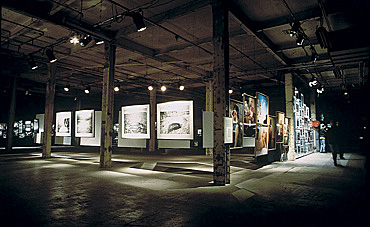
PHOTOGRAPHY 96 TAMPERE
The new means of expression of Finnish documentary at Finlayson's Siperia
When the map of Europe was drawn anew in the 90's, it resembled to a surprising amount the map of the 20's with its small nation-states. Photography 96 Tampere took an inventory of Finnish documentary photography, and it made the fierceness of its crisis tangible. The works of 20 photographers were hung in the old factory milieu and its dark and high Siperia-hall. Jukka Male's and Jaakko Heikkilä's classically straight photographs of people witnessed the recognition of tradition and the vigour of humanistic-emphatic documentary. Veli Granö's, Jorma Puranen's and Marja Pirilä's works cross-expose people from the perspective of time and space. Their subjects are at the same time models and narrators. Some of the photographers of Nykyaika brought their own pictures to the public view as well.

The photos of Antti Haapio, Ami Hyvärinen, Petri Nuutinen, Asko Salminen, Irja Samoil and Taina Värri shed light on the heterogeneity of local photography.
The development took place in Finnish photography as elsewhere in Europe as well. Conceptual ideas were applied to documentary photography. The collage-like exhibition built in the Siperia-hall even exhausted with its massiveness. If some photography exhibitions have been shown in too small spaces, then Siperia-hall was like a laboratory, where the viewers felt themselves to be a part of the multifarious worlds - rooms without walls - of the art works. Besides the large prints there were CD-ROM's, video installations, space-, sound- and light-works. This told about a new kind of commitment of photographers to the increasingly polymorphous expressive field of photography.
Because of university-level studies, Finnish photography has become more academic at the same as it has become an established art form. The discussion started by Raoul Grünstein, Asko Mäkelä and Inari Teinilä at Ylioppilastalo in Tampere reflected well the expansion of documentary photography to the direction of art, video and film. According to Grünstein, a document can record, analyse, reveal, bend and express. He also considered self-expression to be important.
The discussion about the reality of photography was no longer limited to the problematical theme of objectivity, but also concretised in the fashionable concepts of discursion theory and identity, already familiar from the world of science. The fact that no workshops were organised in Photography 96 Tampere was symptomatic: instead the transitional phase of Finnish photography was regarded and appraised. Self-analysis has brought about schools in Finnish documentary photography, which see photography as a very different means of expression of communication and art. Although Finnish cultural discussion is often rather conceptually limited, there has been an attempt to accept different ways to approach photography, different genres. Post-modern and conceptual photography and its theoreticians have not completely devoured the strong Finnish documentary photography, although documentary based on tradition and visual narrative have been undermined.
The exhibition spaces of Nykyaika have changed and it has become one of the photographic centres in Finland. Besides the Finnish Museum of Photography in Helsinki, regional photographic centres have specialised in different concepts of activities and photographic traditions. Tampere is the centre of documentary photography.